It all went down on August 8th, 9th, and 10th in Cheyenne, Wyoming at Thunder Beast Arms’ facilities. The 2023 Silencer Summit, the first of what will likely become an annual event (perhaps a traveling one), was effectively a silencer decibel measuring drag race. Suppressors from dozens of manufacturers — over 185 silencer/gun combos! — were tested with the best dB measuring equipment positioned in three metering locations and run by the sound testing experts at B&K.
Representatives from at least 17 of the suppressor manufacturers were in attendance, and third parties such as Silencer Shop and B&K handled most of the actual silencer verification and installation, shooting, and metering. ALL of the data collected is available HERE, including raw meter data, audio waveforms, live charts (click the top of a column and the entire chart will sort itself by that metric), and much more.
What many people aren’t aware of is just how difficult proper dB metering of a gunshot is. Even with a dB meter developed for this sort of incredibly brief impulse noise that’s capable of capturing volume levels this high and that’s properly calibrated, etc. etc., the number of other factors that affect a suppressed gunshot’s dB reading are shocking and are difficult to control for.
For instance, temperature and humidity have a large effect on the decibel level of a suppressed gunshot. So much so that measuring in the morning vs. in the afternoon can dramatically change the readings. Different ammo, different buffer springs and buffer weights, different amounts of carbon fouling on an AR-15’s bolt carrier group, different gas system settings, different barrel lengths, different dB meter calibrations and settings, and soooo many more factors can drastically skew sound pressure levels. Basically, just because the same dB meter measured one silencer in the morning and a different silencer in the afternoon does not mean those two measurements can be meaningfully compared to each other to determine which silencer is quieter.
To get around all of this, the 2023 Silencer Summit was conducted indoors in a climate-controlled environment under strict conditions with matched ammunition, shared firearms, carefully controlled dB meter locations and calibrations, and more.
Now, I know what you’re thinking. Tested indoors? But what about the sound echo / reflection off the walls and floors and ceiling and such? The crazy thing is, it doesn’t matter one bit. The peak sound of a gunshot takes place so dang quickly (within a fraction of one millisecond) that it’s long-since over before the reflection of the gunshot off the walls makes it to the meter (~25 milliseconds).
In the chart above, the green line represents the dB metering result of firing a 223 Remington outdoors, and the purple line is firing the same setup indoors. The huge peak at 0.05 seconds (50 milliseconds) is the gunshot and it’s identical in both cases, then there’s the sound reflection off the ground at about 0.057 seconds that’s actually lower in the indoor test (the ground inside the building is sand, whereas the ground outside is compacted dirt), then there are sound reflections off the walls beginning at about 0.074 seconds that only exist in the indoor testing, of course.
Heck, the B&K PULSE meter is so fast that it can be used to easily differentiate the peak dB from the gunshot leaving the muzzle followed by the port pop after the action unlocks (which, as you can see above, is why an AR-15 is so loud at the shooter’s ear compared to a bolt-action rifle).
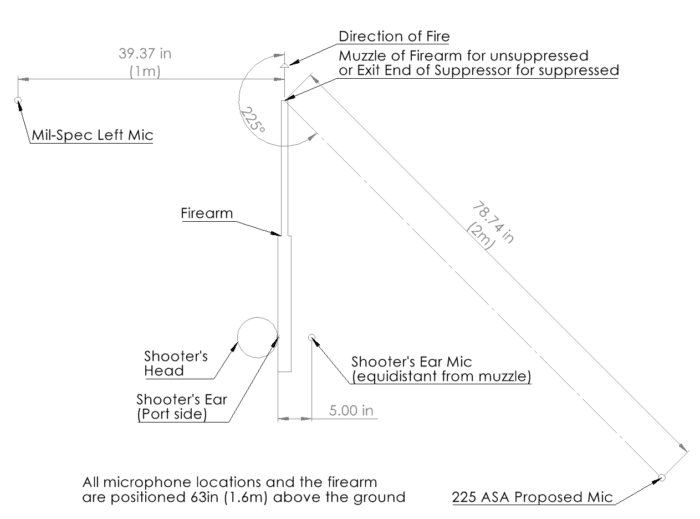 A valuable and unique aspect of the 2023 Silencer Summit’s testing was taking simultaneous measurements from three locations relative to the firearm. One was the location that has been industry standard, as it’s the military-specified test position: one meter left of the muzzle at 1.6 meters microphone and muzzle elevation. The second position has become increasingly popular since it’s what most recreational shooters care about most: “shooter’s ear.” Finally, the American Suppressor Association (ASA) has suggested a metering position two meters back from the muzzle at a 225-degree angle.
A valuable and unique aspect of the 2023 Silencer Summit’s testing was taking simultaneous measurements from three locations relative to the firearm. One was the location that has been industry standard, as it’s the military-specified test position: one meter left of the muzzle at 1.6 meters microphone and muzzle elevation. The second position has become increasingly popular since it’s what most recreational shooters care about most: “shooter’s ear.” Finally, the American Suppressor Association (ASA) has suggested a metering position two meters back from the muzzle at a 225-degree angle.
In each of these three positions, there are six (SIX!) different ways to view and weight the sound pressure level: peak pressure (Pa), peak pressure (dB), peak pressure (dBA), Impulse (Pa*ms), Impulse (dB*ms), and Leq(10ms) dBA. From the official results write-up:
a. Peak – The maximum value in the curve, applies to Pa, dB and dBA
b. LEQ – Leq is a “sound energy metric” – Leq defines an equivalent constant sound energy for a fluctuating curve. It is calculated by averaging the SPL (sound pressure level) over the defined time frame and then converting that value to decibels. The LEQ curve becomes a time average sound level. In our case we are using Leq(10ms) dBA so the window for each Leq (dBA) value is a 10msec SPL average.
c. Impulse – Obtained using the Euler method where area under the curve is calculated by multiplying the value and the time interval, applies to Pa*ms and dB*ms
d. Pa-dB conversion – 20*log(Pa/Po) where Po=2e-5 Pa (Pascal equivalent of 1dB)
d. dB vs dBA – In this document, dB is used to refer to unweighted dB. dBA is used to refer to A-weighted dB.
If you’ve read my silencer reviews, related articles, or maybe even comments below articles you may have noticed that I pretty firmly advise people to not chase dB numbers when selecting a suppressor. Given a “hearing safe” amount of sound reduction, factors like length, weight, mounting system, caliber and rate-of-fire ratings, design (traditional/flow-through, modular/not, etc), and sound tone are far more important for a positive ownership and use experience. Basically, the only reason to choose suppressor A over suppressor B based on A being a few dB quieter is if A matches or beats B in all those other categories first.
For this reason, I do suggest looking at these other factors and metrics first to narrow your list down to a few options that work for your use, and then comparing dB measurements. And, frankly, I’m only now suggesting that last step because of the 2023 Silencer Summit.
This is the first time data of this quality and reliability has been available. Previously, dB numbers from one manufacturer could absolutely not be fairly compared to those from another, or even numbers taken by the same person with the same meter but under differing atmospheric conditions or with ammo or firearms that weren’t strictly controlled. The Silencer Summit dB meter data is as consistent, accurate, and extensive as the industry has ever produced.
It’s so very cool to see the industry come together to take part in this sort of testing for the benefit of us, the consumer!
Imagine, if you will, being in the shoes of the manufacturers who showed up for the Silencer Summit. JK Armament, for example, is a new kid on the block as suppressor brands go, and they showed up with the only fully modular rifle silencers in the test (and did extremely well in 5.56 testing, by the way). That takes some courage! For all of these manufacturers. They’re putting it all on the table and letting a third party “fact check” all the marketing hype.
Not gonna lie, there are some surprises in the results! I was, of course, not surprised to see AB Suppressor kicking some butt, as they’re the brand we’ve selected at Black Collar Arms (both as suggested pairings with our standard rifles and on a joint design for our integrally suppressed rifles) due to their amazing performance, light weight, and great designs. I did hear “who the heck is AB?” from a few industry friends after the Summit wrapped! Seems that courage paid off for the smaller companies that performed well enough to get noticed. At the same time, yes, there are surprises among brands and models at the bottom of the dB performance list that were expected to perform better.
Turns out I own two of the top three suppressors (that’s the AB A-10 on the left and the JK SBRX on the right in the photo above). Not a surprise, because I chose ’em for a reason, but it’s nice to see it validated through formal, controlled testing.
As TBAC hosted this year’s event, all of the results are on their website HERE. Go peruse and data dive to your heart’s content!
I’m excited and hopeful for the prospect of this becoming an annual thing. This sort of objective data collected in a controlled manner can do nothing but help the industry! It provides consumers with fantastic comparison data that we want — for once it can actually be used to compare fairly! — and it provides manufacturers with further incentive and motivation to create a better product.
Here’s a video from The Gun Collective covering the event:
Finally, I’d just like to recognize once again how much courage it took for the manufacturers who participated in this event to do so, and to thank them for doing it.

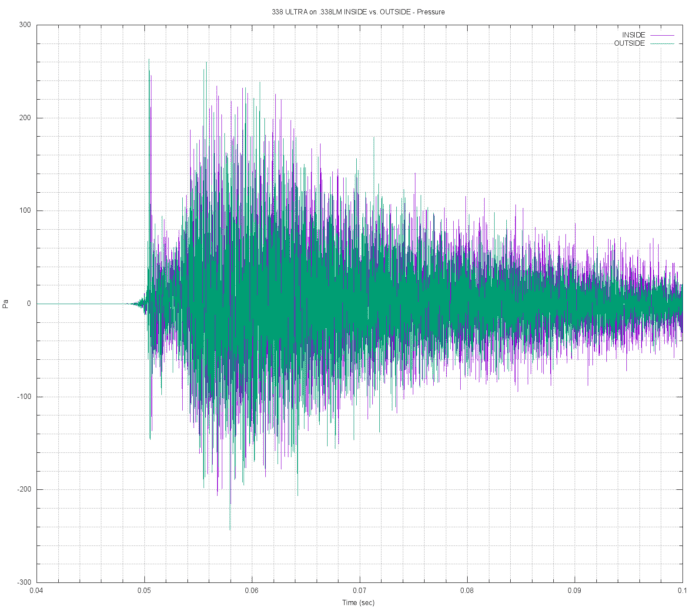

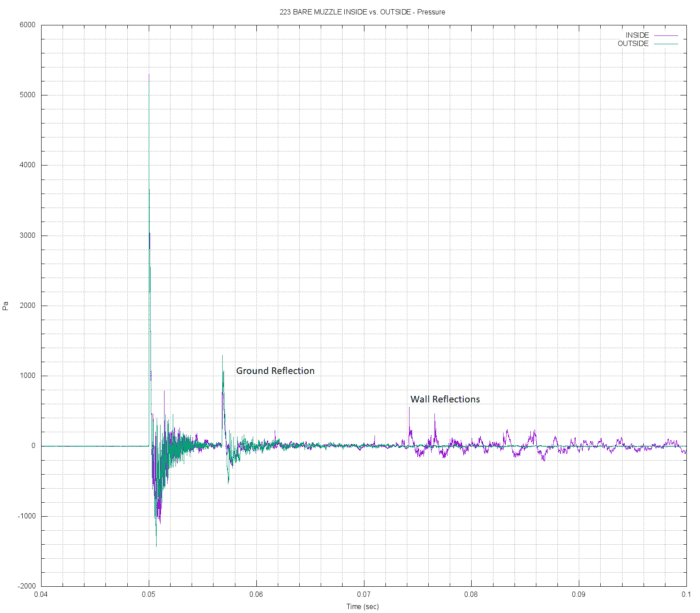
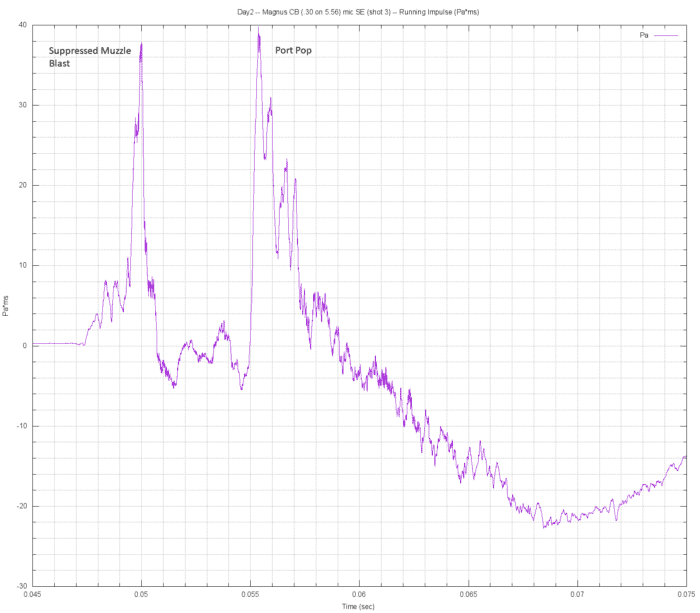

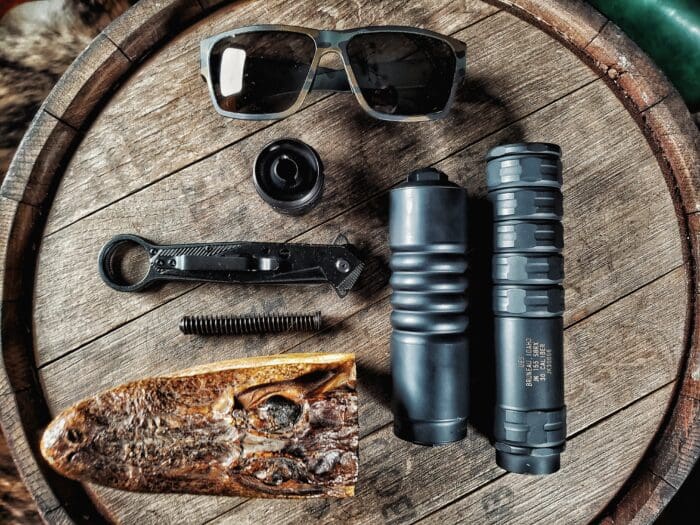



shhh…
something interesting just happened…I got an e-mail from firearms news that featured an ad for threaded glock barrels…when I tried to open it someone…[google?, microsoft?] shut it down…something about a 403…what’s that all about?
I’ll take a box of bullets and that silencer please.
.
Okay the silencer is $56 but you’ll have to fill out this form, wait 2 years, register the weapon your using the bullets in, and when the BATFE says it’s okay you can come back and pick up your bullets.
The 2023 Silencer Summit Was a Big Success, and quiet too.
More Ammo!!! SIG Announces Plan To Make It So.
https://www.youtube.com/watch?v=iynbqbt48EY
UPDATE FROM ISRAEL (OCT. 10TH). A scary find on regained territories.
https://www.youtube.com/watch?v=2ZtxsT3nYfA
Ventilating a crawlspace is an important step in preventing moisture from accumulating and promoting mold growth
When are they going to announce if there will be a 2024 summit, and where it will be held?
Comments are closed.